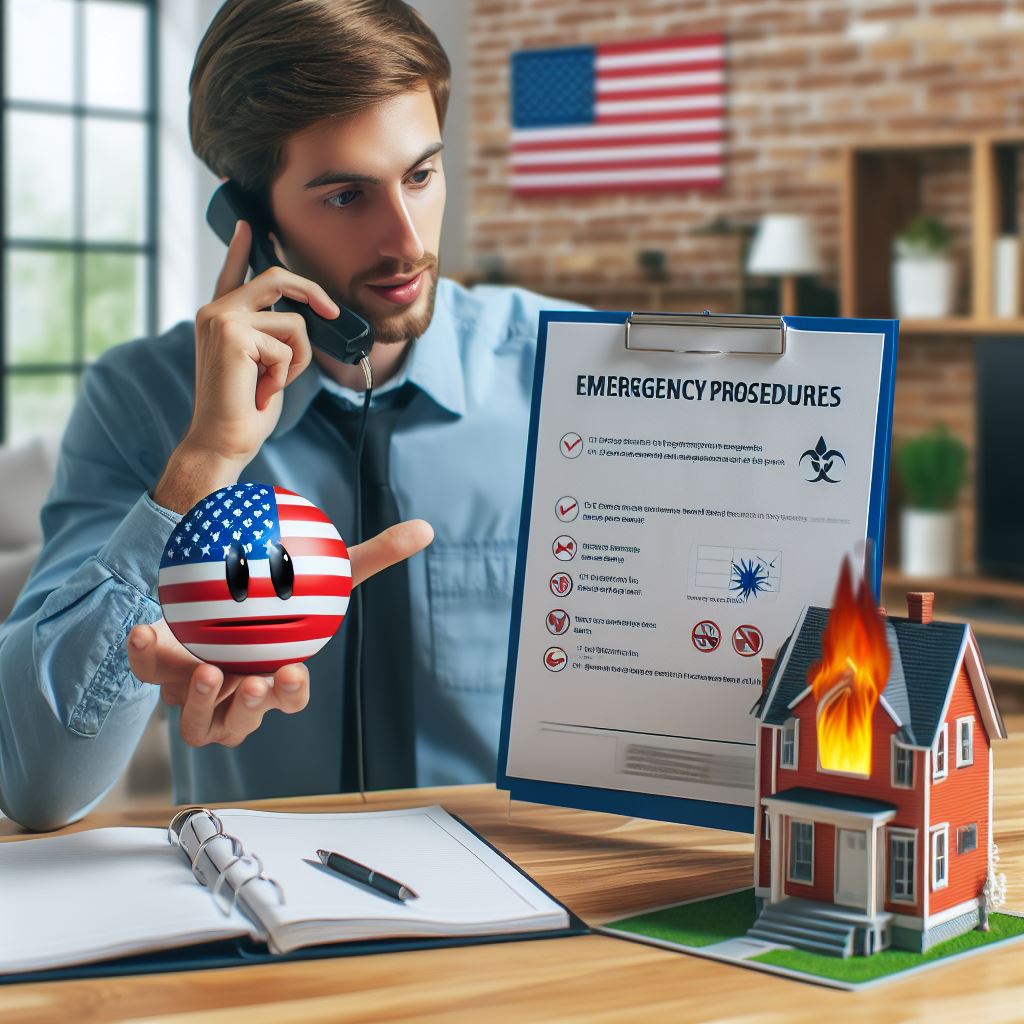Introduction
Natural disasters are unpredictable events that can cause significant damage and loss of life.
Property managers have a vital role in disaster preparedness to minimize the impact of these events.
Natural disasters refer to extreme and sudden occurrences caused by natural forces, such as earthquakes, hurricanes, floods, wildfires, or tsunamis.
These events can result in widespread destruction and disruption.
Importance of Disaster Preparedness for Property Managers
Disaster preparedness is crucial for property managers as they are responsible for the safety and well-being of tenants and the preservation of properties.
By being prepared, property managers can effectively respond to emergencies and mitigate potential damages.
Firstly, property managers need to create comprehensive emergency plans that outline evacuation procedures and communication channels.
These plans should be regularly reviewed and updated to address changing risks and circumstances.
Secondly, property managers must ensure that their buildings are constructed and maintained to withstand natural disasters.
This includes implementing proper structural reinforcements and utilizing resilient materials.
Thirdly, property managers should establish relationships with emergency service providers and neighboring property managers to facilitate a coordinated response during disasters.
Moreover, property managers should encourage tenants to prepare for emergencies by providing them with safety tips and resources.
This includes information on emergency kits, evacuation routes, and important contact numbers.
Lastly, property managers must conduct regular drills and training sessions to ensure that both staff and tenants are familiar with the emergency procedures.
In essence, disaster preparedness is imperative for property managers to protect their assets and the people they serve.
By taking proactive measures, property managers can effectively respond to natural disasters and ensure the safety and well-being of everyone involved.
Understanding Natural Disasters
Natural disasters are events caused by natural forces that result in significant destruction and loss of life.
These disasters can take several forms, including hurricanes, earthquakes, floods, wildfires, and tornadoes.
Different Types of Natural Disasters
- Hurricanes: These powerful storms form over warm ocean waters and can cause strong winds, storm surges, and heavy rainfall.
- Earthquakes: Earthquakes occur when there is a sudden release of energy in the Earth’s crust, resulting in shaking of the ground.
- Floods: Floods can result from heavy rainfall, dam failure, or rapid snowmelt, causing water to overflow and inundate areas.
- Wildfires: These are uncontrolled fires that rapidly spread through vegetated areas, fueled by dry conditions and strong winds.
Potential Impacts on Properties and Communities
Natural disasters can have devastating effects on properties and communities, leading to severe damage and disruption of everyday life.
Here are some potential impacts:
- Property Damage: Buildings, infrastructure, and belongings can be destroyed or significantly damaged by natural disasters.
- Injuries and Fatalities: Natural disasters can cause injuries and loss of life among residents and emergency responders.
- Displacement: People may be forced to evacuate their homes and seek temporary shelter due to the destruction and safety hazards.
- Economic Losses: The cost of rebuilding and repairing damaged infrastructure and properties can be substantial, impacting local economies.
- Disruption of Services: Natural disasters can disrupt essential services such as power, water, transportation, and communication systems.
Historical Examples of Devastating Natural Disasters
Throughout history, there have been numerous natural disasters that have caused massive destruction and loss of life. Here are a few notable examples:
- 1906 San Francisco Earthquake: This powerful earthquake, with a magnitude of 7.8, caused widespread fires and destruction in San Francisco, resulting in an estimated 3,000 deaths.
- 2005 Hurricane Katrina: Katrina, a Category 5 hurricane, devastated New Orleans and the Gulf Coast region, causing over 1,200 fatalities and billions of dollars in damages.
- 2011 Tohoku Earthquake and Tsunami: A massive 9.0 magnitude earthquake struck off the coast of Japan, triggering a tsunami that killed over 15,000 people and caused a nuclear disaster.
- 2017 Hurricane Harvey: Harvey unleashed catastrophic flooding in Houston and Southeast Texas, displacing thousands of residents and causing billions of dollars in damages.
- 2020 Australian Bushfires: These unprecedented wildfires burned millions of hectares, destroyed thousands of homes, and resulted in the loss of both human and animal lives.
Understanding the different types of natural disasters and their potential impacts is crucial for property managers.
By being prepared and having a comprehensive disaster response plan in place, property managers can help minimize damage, protect residents, and ensure a swift recovery in the aftermath of a natural disaster.
Read: Navigating Property Management Legal Risks
Risk Assessment and Planning
Conducting a thorough risk assessment for the property
One of the most important aspects of natural disaster preparedness for property managers is conducting a thorough risk assessment for the property.
- Identify potential vulnerabilities and exposures by carefully examining the property’s location and surrounding environment.
- Consider the property’s proximity to bodies of water, fault lines, or areas prone to severe weather conditions.
- Assess the building’s structural integrity and the stability of its foundation, walls, and roof.
Developing an emergency response plan tailored to the property
Based on the findings of the risk assessment, develop an emergency response plan tailored to the specific property.
- Establish clear evacuation routes and designate safe areas within the property where tenants can take shelter.
- Consider the needs of tenants with disabilities when developing the emergency response plan.
- Ensure that emergency equipment such as fire extinguishers, first aid kits, and emergency lighting are readily available throughout the property.
Regularly review and update the emergency response plan as needed to account for any changes in the property or its surroundings.
Establish strong communication channels with tenants, emergency services, and local authorities
Additionally, it is crucial for property managers to establish strong communication channels with tenants, emergency services, and local authorities.
- Provide tenants with clear instructions on what to do in the event of a natural disaster.
- Ensure all tenants have access to emergency contact information and know how to report any issues or concerns.
- Collaborate with local emergency services and authorities to stay informed about potential threats and receive real-time updates.
Implementing preventive measures to reduce the impact of natural disasters
Property managers should also consider implementing preventive measures to reduce the impact of natural disasters on the property.
- Invest in high-quality construction materials and techniques that can withstand severe weather or geological events.
- Regularly inspect and maintain the property’s infrastructure, including the roof, plumbing, and electrical systems, to prevent potential hazards.
- Install backup generators to ensure access to essential services during power outages.
Educate tenants about natural disaster preparedness
Lastly, property managers should educate tenants about natural disaster preparedness.
- Provide informational materials and resources that outline safety measures and evacuation procedures.
- Organize drills and exercises to familiarize tenants with the emergency response plan.
- Encourage tenants to assemble emergency supply kits that include food, water, medication, and other essential items.
By conducting a thorough risk assessment, developing an effective emergency response plan, and implementing preventive measures, property managers can significantly mitigate the impact of natural disasters on their properties and ensure the safety of their tenants.
Read: Property Management: Essential Insurance Insights
Building Maintenance and Upgrades
Building maintenance and upgrades are crucial for ensuring the structural integrity and resilience of properties managed by property managers.
Regular inspections and maintenance are essential in identifying potential weaknesses and addressing them promptly.
Additionally, implementing upgrades to withstand natural disasters is vital in protecting properties and their occupants.
Ensuring Structural Integrity and Resilience
- Regularly inspect buildings for any signs of structural damage or vulnerabilities.
- Hire professional engineers or contractors to assess the integrity of the property.
- Identify weak areas such as foundations, walls, roofs, and windows that may require reinforcement.
- Strengthen structures by using materials that are resistant to impact, vibration, and extreme weather conditions.
- Follow building codes and regulations to ensure proper construction techniques and standards.
Regular Inspections and Maintenance
- Create a maintenance schedule that includes routine inspections, repairs, and replacements.
- Inspect the property’s electrical and plumbing systems to prevent hazards and leaks.
- Check for signs of water intrusion, such as mold or dampness, to avoid long-term damage.
- Regularly service and maintain elevators, fire suppression systems, and other safety equipment.
- Address any identified issues promptly to prevent further deterioration or potential hazards.
Implementing Upgrades to Withstand Natural Disasters
- Install impact-resistant windows and doors to protect against high winds and flying debris.
- Retrofit buildings with earthquake-resistant foundations, bracing, and reinforcements.
- Invest in storm shutters or hurricane-resistant roofing systems to safeguard against severe storms.
- Consider reinforcing structural connections, such as anchor bolts and straps, to resist strong forces.
- Integrate advanced warning systems for earthquakes, floods, or other natural disasters.
Creating Emergency Response Plans
- Develop and communicate emergency plans to property occupants, including evacuation procedures and designated assembly areas.
- Install visible and easily accessible emergency exit signs and lighting throughout the property.
- Educate tenants and staff on the proper use and maintenance of fire extinguishers and other safety equipment.
- Establish communication protocols with local authorities, emergency services, and neighboring properties.
- Conduct regular drills and training exercises to ensure preparedness and familiarize everyone with the emergency procedures.
Insurance and Documentation
- Review and update insurance policies to ensure adequate coverage for natural disasters.
- Maintain detailed records of the property’s condition, repairs, and upgrades for insurance claims.
- Document any changes made to the property to provide evidence of compliance with safety regulations.
- Keep records of emergency contacts, including insurance providers, contractors, and emergency services.
- Regularly review and update emergency contact information to ensure accuracy and accessibility.
By prioritizing building maintenance and upgrades, property managers can effectively enhance the resilience of properties, mitigating the potential impact of natural disasters.
Regular inspections, prompt repairs, and the implementation of necessary upgrades are essential in safeguarding the property, its occupants, and minimizing potential risks.
Investing in building resilience also demonstrates the commitment of property managers towards providing a safe and secure environment for their tenants.
Read: Rainwater Harvesting for Properties

Tenant Education and Communication
One of the most important responsibilities of property managers is to ensure the safety and well-being of their tenants.
This includes being prepared for natural disasters and emergencies.
Here are some ways property managers can educate and communicate with tenants about disaster preparedness.
Keeping tenants informed about emergency plans and procedures
- Hold regular meetings or send out newsletters to inform tenants about emergency plans and procedures.
- Clearly display evacuation routes and emergency contact information in common areas and near building entrances.
- Provide tenants with a comprehensive guide on what to do in different types of emergencies, such as earthquakes, floods, or fires.
- Use digital communication tools like email or text messages to send timely updates and reminders about emergency protocols.
Providing resources and training for tenants to prepare for disasters
- Organize workshops or webinars on disaster preparedness, inviting experts to share tips and best practices with tenants.
- Create an emergency kit checklist for tenants, including essential items such as flashlights, batteries, and first aid supplies.
- Collaborate with local organizations or authorities to offer CPR and first aid training to interested tenants.
- Share informative articles or videos through newsletters or social media platforms to help tenants better understand disaster preparedness.
Establishing communication channels to relay important information
- Set up a dedicated emergency hotline or communication system that tenants can call or text during emergencies.
- Create a designated webpage on the property’s website where tenants can access important emergency information and updates.
- Encourage tenants to provide their contact information and emergency contacts in case of an evacuation or other emergency situations.
- Utilize social media platforms to share real-time updates, news, and tips during natural disasters.
Educating and communicating with tenants about disaster preparedness is crucial for property managers to ensure their safety and well-being during emergencies.
By keeping tenants informed, providing resources and training, and establishing effective communication channels, property managers can play a significant role in disaster preparedness efforts.
Remember, the more prepared tenants are, the better equipped they will be to handle emergencies, minimizing potential risks and damages.
Read: Sustainable Flooring Options for Rentals
Collaboration with Local Authorities and Organizations
Building relationships with local emergency management agencies is crucial for effective disaster preparation.
Utilizing resources and guidance from organizations specialized in disaster preparedness can provide valuable support and knowledge.
Participating in community disaster planning initiatives fosters collaboration and strengthens disaster response efforts.
Building Relationships with Local Emergency Management Agencies
- Establishing regular communication channels with local emergency management agencies is essential.
- Attending meetings and events organized by these agencies helps property managers stay informed.
- Collaborating with emergency management agencies allows property managers to contribute to planning and decision-making processes.
- Sharing information about property vulnerabilities and readiness helps emergency management agencies understand the community’s needs.
- Working together, property managers and local authorities can create effective evacuation plans and ensure swift response during disasters.
Utilizing Resources and Guidance from Disaster Preparedness Organizations
- Identifying and partnering with organizations specialized in disaster preparedness offers valuable expertise.
- These organizations provide training, resources, and guidance on developing comprehensive disaster preparedness plans.
- Accessing their tools and knowledge equips property managers to tackle various disaster scenarios effectively.
- Collaborating with organizations focused on disaster preparedness enables property managers to stay updated on best practices.
- By leveraging their expertise, property managers can enhance the safety and resilience of their properties and communities.
Participating in Community Disaster Planning Initiatives
- Engaging in community disaster planning initiatives strengthens relationships with fellow residents, businesses, and stakeholders.
- Collaborating with local organizations and individuals fosters a sense of shared responsibility and promotes community resilience.
- Participating in drills, exercises, and simulations helps property managers refine their emergency response plans.
- Sharing experiences and lessons learned during community disaster planning initiatives improves overall preparedness efforts.
- By actively engaging in these initiatives, property managers contribute to a safer and more resilient community.
In general, collaboration with local authorities and organizations is vital for property managers in disaster preparation.
Building relationships with local emergency management agencies, utilizing resources from specialized organizations, and participating in community initiatives all play a crucial role in ensuring effective response and resilience during natural disasters.
Insurance and Financial Preparedness
Reviewing insurance policies to ensure adequate coverage
When it comes to natural disasters, property managers must be well-prepared to handle the aftermath.
One crucial aspect of preparedness is reviewing insurance policies to ensure adequate coverage.
- Review insurance policies to ensure they cover all potential damages caused by natural disasters.
- Check for exclusions and limitations related to specific types of natural disasters, such as floods or earthquakes.
- Understanding the details of insurance policies will help property managers determine if additional coverage is needed.
Understanding exclusions and limitations related to natural disasters
Aside from insurance coverage, property managers should also establish a financial contingency plan for recovery and reconstruction in case of a natural disaster.
- Calculate the potential costs of repairs, cleanup, and rebuilding after a natural disaster.
- Set aside a portion of the budget specifically for emergency situations.
- Create relationships with contractors and suppliers who can provide services and resources during the recovery process.
Establishing a financial contingency plan for recovery and reconstruction
Property managers should also consider these additional measures for financial preparedness:
- Identify available resources for disaster recovery, such as government assistance programs or loans.
- Research and understand any financial relief options, including grants or tax deductions, for property damage caused by natural disasters.
- Keep important financial documents, such as insurance policies and property valuations, in a secure and easily accessible location.
Ensuring insurance and financial preparedness can greatly minimize the impact of a natural disaster on property managers and their communities.
By reviewing policies, understanding exclusions, and establishing a financial contingency plan, property managers can better protect their assets and recover more efficiently in the event of a disaster.
Conclusion
Being proactive in disaster preparedness is crucial for property managers to safeguard their investments and maintain tenant safety.
By taking the necessary steps to plan, communicate, and implement disaster preparedness measures, property managers can mitigate potential damages and ensure a swift response should a natural disaster occur.
Throughout this blog post, we have discussed the importance of conducting risk assessments, developing emergency plans, and implementing disaster-resistant measures such as reinforcing structures and securing loose objects.
By prioritizing natural disaster preparation, property managers can not only protect their assets but also provide a safe and secure environment for their tenants.
As property managers, it is our responsibility to not only react but also to be proactive in preparing for natural disasters.
By staying informed about potential risks and regularly updating our emergency plans, we can minimize the impact of a disaster and effectively respond to emergencies.
In light of the increasing frequency and severity of natural disasters, we cannot afford to overlook the significance of disaster preparedness.
Therefore, I urge all property managers to prioritize natural disaster preparation and take immediate action to ensure the safety and well-being of their tenants and assets.
Let us work together to create resilient and disaster-ready communities.




